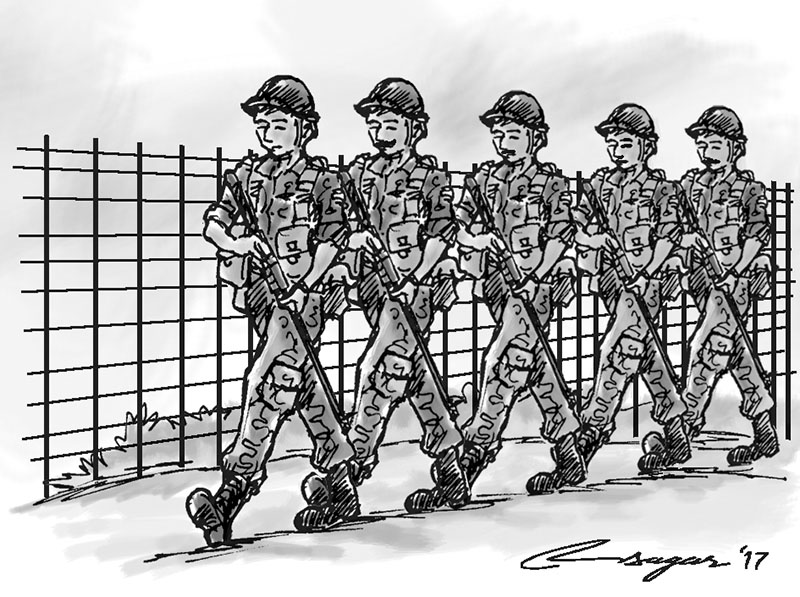Political settlement: Nepal Army�s role
Political settlement: Nepal Army’s role
Published: 02:55 am Feb 24, 2017

The political leadership has failed to influence the military in Nepal. They ousted monarchy but did not learn how to use the military for the betterment of the nation In the late medieval period, the colonial powers like Britain invaded South Asia. After the 17th century, when many tiny states and principalities were quarreling among themselves, and were not really aware of the British move for trading in this part of the world, the visionary King Prithvi Narayan understood the trend and was determined to unify Nepal to counter the British invasion. Likewise, he was fully aware of the development of China in Tibet and cautious to manage geopolitics as well. The Nepal Army’s military history coincides with the country’s history, because the rulers used the military as the tool to prolong their regime. The rulers after Prithvi Narayan and Bahadur Shah were neither innovative nor creative to administer the conquered territory as a nation. From 1743, when the Nepal Army was founded, at times it was left at the disposal of the Shah rulers to de-facto powers like Bhimsen Thapa and Jung Bahadur. In the process of democratic transition, it was also used to crush insurgency. The justification for this may be debatable, but the army was always loyal to the regime which was formed by popular mandate. Nepal’s geopolitical location also compelled the country to take care to please the two giant neighbours in the south and north. Bhimsen Thapa failed in his endeavour to retain Greater Nepal and was compelled to sign the 1816 Treaty with the East India Company, which confined his dominion to Nepal’s present boundary. But Jung Bahadur Rana managed to please the British by providing them military support, both lawful and unlawful. In return, he regained the lost territory of Banke, Bardiya, Kailali and Kanchanpur from the British in 1860. Under Bahadur Shah and Bhimsen Thapa, the Nepalis conquered not only the hill states of the Gandaki and Karnali basin but also Kumaon and Garhwal, which are now part of the Indian state of Uttarakhand. The eastward expansion reached up to Tista River by Prithvi Narayan Shah himself. The westward drive was halted partially due to Nepal’s aggressive policy towards Tibet over trade and border issues, triggering a Chinese invasion. Also, Ranjit Singh, the ruler of Punjab, checked Nepal’s westward move on the Sutlej in the winter of 1809-10. However, Bahadur Shah was an oppressive ruler in contrast to his father. Prithvi Narayan Shah always apprehended resistance from the Chaubisi while he was expanding eastward. Some historians believe that he bribed the Chaubisi not to invade Gorkha while he was engaged in the east. Bahadur Shah on the other hand neither played a defensive role nor realised that such a policy was essential because his eastern flank was always secured. Perhaps Bahadur Shah had made a mistake in opening up a two-front war. His father always believed in a single-front war. The westward expansion campaign was ongoing when he decided to fight Tibet. Although he succeeded in concluding a treaty with Tibet in 1789, Tibet’s resentment led China to get involved in a war with Nepal in 1792. Some intellectuals believe that the agreement after the war with China compelled Nepal to become its tributary. Later, Jung Bahadur instead of sending a mission opted for military confrontation with Tibet in 1856 that paved a better position for Nepal over Tibetan issues. In its history, Nepal Army was not properly guided by the leadership to keep pace with its civilian counterparts for national development. Unless the role of the National Security Council (NSC) is enlarged beyond to army mobilisation, we cannot expect enhanced security in Nepal. The constitution of 2015 fails to recognise NSC as an autonomous body responsible for the security at large. It has added a few more members to the NSC, including a chief secretary who does not fall in this domain, but excludes an opposition leader who could be an asset to encompass divergent views to frame an inclusive national security strategy. In addition, there is no ‘National Security Adviser’ to render legitimate expert advice to the government and mobilize elements of national power as well. Rather, the Defence Secretary, who is not a security expert, has been made coordinator of the council. With its structure dominated by the defence ministry, the NSC thus looks like a defence council rather than a security council. Unless the feudal mindset is changed in the defence bureaucracy and the entire system becomes inclusive, the military alone cannot ensure national security. The political leadership has failed to influence the military in Nepal. They ousted monarchy but did not learn how to use the military for the betterment of the nation. The monarchy was advised by the Principal Military Secretary to frame a national security strategy; but the present leadership does not know how to use this skill as they have neither a trusted defence institution nor a think tank among them. They do not understand that security is an art as well as a science of employing a nation’s intellectual, political, economic, informational and military powers to achieve national security objectives. And this ‘national security objective’ must be guided by well defined ‘national interests’. So, the role of Nepal Army in the present political context should be to explore ‘military diplomacy’ to institutionalize the defence mechanism via the ‘culture of consensus’ and ‘inclusiveness’ for stable Nepal. Bhattarai is a Retired Brigadier General
